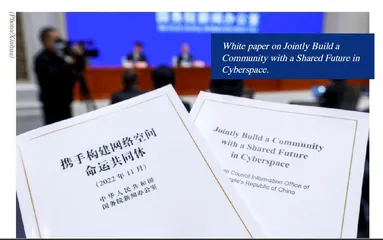National Security Dilemma in the Digital Era and the Building of a Community with a Shared Future in Cyberspace
作者: Lang Ping

A review of the history of human development shows that every major technological revolution brings new challenges to national security. With the advent of the information technology revolution represented by the Internet, cybersecurity has become an issue of paramount importance, and the digital intelligence revolution with digital technology innovations such as big data and cloud computing has further expanded the connotation and extension of cybersecurity, which has been on a par with national security in the digital age. At present, the digital space has become an arena for competition between major countries. Against the highly uncertain security threats and risks in the digital age, joint governance or confrontation and split of the international community will determine, to a large extent, the future of human development.
National Security Environment in the Digital Age
With the acceleration of innovative applications and integrated development of digital technology, the digital, networked and intelligent revolution is unfolding around the world, and the digital economy has become a new driving force and engine for world economic growth and industrial transformation. Meanwhile, the widespread application of digital technologies also brings more and wider security risks, and national security faces greater uncertainty and complexity in the evolving technological development. This is manifested in the continuous ravages of malicious cyber activities such as cyberattacks and cybercrimes. Meanwhile, data security and artificial intelligence security risks are oncoming and intertwined with cybersecurity risks. National security environment in the digital era has changed from the Internet age to an era of digital intelligence .
In the Internet age, countries are facing two types of security threats which are technical and social. Security threats at the technical level exist in all aspects of the cyberspace system, and security threats at the social level are mainly cybercrime, cyberterrorism, infringement of personal information and privacy, public opinion warfare and information warfare in the context of information manipulation. The national security risks in the Internet era mainly come from the technical vulnerabilities of the Internet itself and the artificial use or weaponization of the application layer and content layer of cyberspace. In other words, the higher the degree of informatization of a country, the greater its dependence on network facilities, and the higher the security risks it faces. The United States, the creator of the Internet with the most powerful cyber strength in the world, has successively introduced offensive cybersecurity strategies such as “defend forward”, “persistent engagement”, “layered deterrence” and “hunt forward”, but also faces many cybersecurity threats.
In recent years, boosted by the wave of the Internet, important progress has been made in digital technologies such as big data, cloud computing, Internet of Things, and artificial intelligence. Digital economy and real economy have been deeply integrated with the cyberspace, thus ushering in the era of digital intelligence. An important feature of this era is the emergence of a convergence ecosystem of digital technology, and every technological innovation is backed up by other technological breakthroughs. Whether it is the prospect of the Internet of Everything or the wide application of artificial intelligence, it needs to rely on strong Internet infrastructure, and continuous improvement of big data technology and computing power. On the other side, security threats in cyberspace have also taken on new features of convergence. Whether it is the mutation and upgrading of cyberattack tools or the expansion of attack effects and scope of influence, supply chain security, data security, and artificial intelligence security not only are vital to a country’s industrial and economic security, but also penetrate into all aspects of the country’s political, economic, social, and military fields, with wide-ranging implications.
In particular, the major breakthroughs in strong artificial intelligence have attracted great attention for the security risks they brought about. Ian Bremmer, political scientist and president of the Eurasia Group, a consulting firm that studies global political risks in the United States, pointed out that the iterative upgrade rate of generative AI is beyond imagination. Countries try to control AI and make it available for their own use, but it is far from keeping up with the upgrade and popularization of AI. This technology is likely to threaten the status of the nation states as a force to shape of geopolitical order in the world and will trigger a fundamental shift in the global power structure and balance.
State Actors in the Digital Security Dilemma
The security risks accumulated during the continuous evolution of the digital age have become an important feature of the changes of the current era, and the profound adjustment of the balance of power between major countries has led to the intensification of major country competition, which has become not only the root cause of the national security dilemma in the digital age, but also an important fulcrum for the evolution of international relations in the digital age. Security has always been the most fundamental interest of state actors in a state of anarchy, and the protection of a country from major security threats and the elimination of security fears are the most fundamental needs for their participation in international interactions. Changes in the international environment in the digital age are having an impact on the behavior of states in the international system.